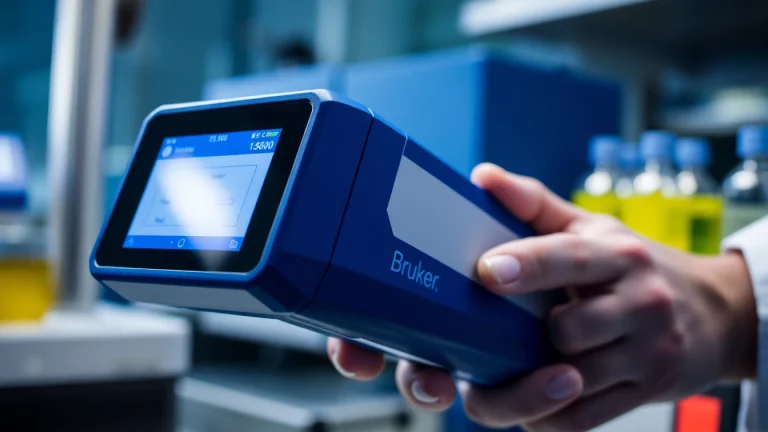
Enhance Your Analysis with the Bruker EOS 500 Handheld LIBS Analyzer: Features and Benefits
Introduction to the Bruker EOS 500 Handheld LIBS Analyzer
The field of analytical science is witnessing a significant transformation with the emergence of portable analytical instruments. Among them, the Bruker EOS 500 Handheld LIBS Analyzer stands out as a powerful solution for on-site material analysis. This advanced device is designed for various applications, ranging from metallurgy to environmental studies, by utilizing Laser-Induced Breakdown Spectroscopy (LIBS) technology. This article delves into what makes the Bruker EOS 500 an exceptional tool for professionals across multiple industries.
What is the Bruker EOS 500?
The Bruker EOS 500 is a handheld and portable analytical device that leverages LIBS technology to provide rapid and accurate elemental analysis of materials. Unlike traditional lab-based equipment that may require substantial setup and time, the EOS 500 offers immediate results, enhancing decision-making processes in the field. The analyzer can identify and quantify elements in solid, powder, and liquid samples, making it a versatile tool for various applications.
Key Applications of LIBS Technology
LIBS technology has seen extensive implementation across different sectors due to its rapid analytical capabilities and high sensitivity. Notably, the Bruker EOS 500 is employed in:
- Metallurgy and Mining: Efficiently detecting elemental composition in ores and metals to optimize processing and extraction strategies.
- Environmental Monitoring: Assessing soil and water for contamination, allowing for timely interventions and environmental protection.
- Manufacturing and Quality Control: Ensuring product quality by identifying material properties during the manufacturing process.
- Academic Research: Providing precise elemental analysis in various scientific studies, aiding in new discoveries.
Overview of the Analyzer’s Features
The EOS 500 is equipped with a range of advanced features designed to enhance usability and performance. These include a robust user interface, intuitive software for data analysis, wireless connectivity for data transfer, and a compact design that facilitates easy handling in diverse environments. The built-in library of spectral data aids in the identification of a wide range of materials, making it a comprehensive tool for analytical needs.
Advantages of Using the Bruker EOS 500
Portability and Ease of Use
One of the standout features of the Bruker EOS 500 is its portability. Weighing just a few kilograms, it is designed for field use, enabling analysts to perform on-site assessments without the need for laboratory setups. Its ergonomic design facilitates ease of operation, allowing users to hold the device comfortably during analysis. Moreover, the user-friendly interface minimizes the learning curve, enabling operators to start using the device effectively almost immediately.
Rapid Analytical Capabilities
The analytical speed of the EOS 500 is one of its key advantages. Users can obtain results within seconds, allowing for immediate responses to critical situations. This rapid analysis is vital in industries such as mining, where timely decisions can dramatically impact operational efficiency and profitability. Furthermore, the ability to perform analyses in real-time enables data-driven decisions that can enhance safety and productivity.
Cost-Effectiveness in Material Detection
Investing in the Bruker EOS 500 offers significant long-term cost benefits. Traditional laboratory analysis can be resource-intensive, involving shipping samples and waiting for results—as well as the costs associated with downtime. The handheld nature of the EOS 500 eliminates these expenses by providing immediate in-field results without compromising quality. Consequently, analysts can allocate resources more effectively and reduce overall operational costs.
Advanced Features of the Bruker EOS 500 Handheld LIBS Analyzer
Real-Time Data Analysis
With its built-in software, the EOS 500 allows for seamless real-time data analysis. The device captures data on-the-fly, offering users the flexibility to make adjustments or pursue further investigation based on the data received. This real-time capability ensures not only speed but also accuracy in results, promoting better decision-making during critical operations.
Customizable Settings and Protocols
The flexibility of the Bruker EOS 500 extends through its customizable settings and protocols. Users can adapt the device’s operating parameters depending on the application and material types being analyzed. This customization can include adjusting laser energy, focusing configurations, and data collection methods, making the analyzer highly versatile and suitable for varied analytical scenarios.
Integration with Other Laboratory Devices
In a modern analytical workflow, integration with other laboratory devices is crucial for comprehensive analysis. The Bruker EOS 500 offers compatibility with various laboratory instruments, such as spectrometers and data management systems. This capability allows for enhanced analytics, wherein data obtained from LIBS can be further analyzed alongside information from other techniques, enriching scientific research and industrial processes.
Best Practices for Using the Bruker EOS 500
Preparing Samples for Accurate Results
Proper sample preparation is essential to achieve the most accurate results with the Bruker EOS 500. Analysts should ensure that samples are clean and appropriately sized for analysis. Adhering to recommended preparation guidelines specific to the material being tested can dramatically impact the quality and reliability of the results. For instance, solid samples may need to be polished to eliminate surface irregularities that could affect laser interaction.
Maintaining Calibration and Performance
Regular calibration of the EOS 500 is necessary to maintain its precision and reliability. Users should follow the manufacturer’s guidelines for calibration intervals and procedures. Maintaining a log of performance metrics can help users identify when recalibration is needed, ensuring consistent performance over the device’s lifespan. This proactive approach protects against measurement errors that could lead to misinterpretations of data.
Interpreting Results Effectively
Understanding how to effectively interpret the results generated by the Bruker EOS 500 is crucial for practical application. Analysts should be familiar with the elemental detection limits and the potential interferences that could affect the data. Cross-referencing data with established standards or databases can enhance confidence in results, allowing for data analysis to be correctly integrated into broader scientific or industrial conclusions.
Performance Metrics and Case Studies
Success Stories with LIBS Technology
Numerous case studies highlight the successful application of LIBS technology across various fields. For example, in the mining industry, companies utilizing the Bruker EOS 500 have reported improved ore recovery rates and operational efficiencies due to the ability to make quick, informed decisions based on accurate real-time data. Additionally, environmental agencies have employed LIBS systems for fast contamination assessments, leading to more effective remediation strategies.
Comparative Analysis of Results
When evaluating the performance of the Bruker EOS 500, comparative analysis with traditional methods is essential. Multiple studies have illustrated that LIBS offers comparable or superior accuracy in identifying elemental compositions when set against other analytical techniques, such as X-ray fluorescence (XRF). This analysis is crucial for laboratories to understand the advantages and trade-offs of adopting ASS technology in their operations.
Measuring ROI for Laboratories
Determining the return on investment (ROI) for acquiring a Bruker EOS 500 involves analyzing both tangible and intangible benefits. Tangible benefits include savings from reduced shipping and lab costs, while intangible benefits encompass enhanced operational efficiency, improved accuracy, and increased field productivity. Evaluating these factors over a specific period can provide insights into how the EOS 500 adds value to laboratory operations and whether its integration aligns with long-term strategic goals.


